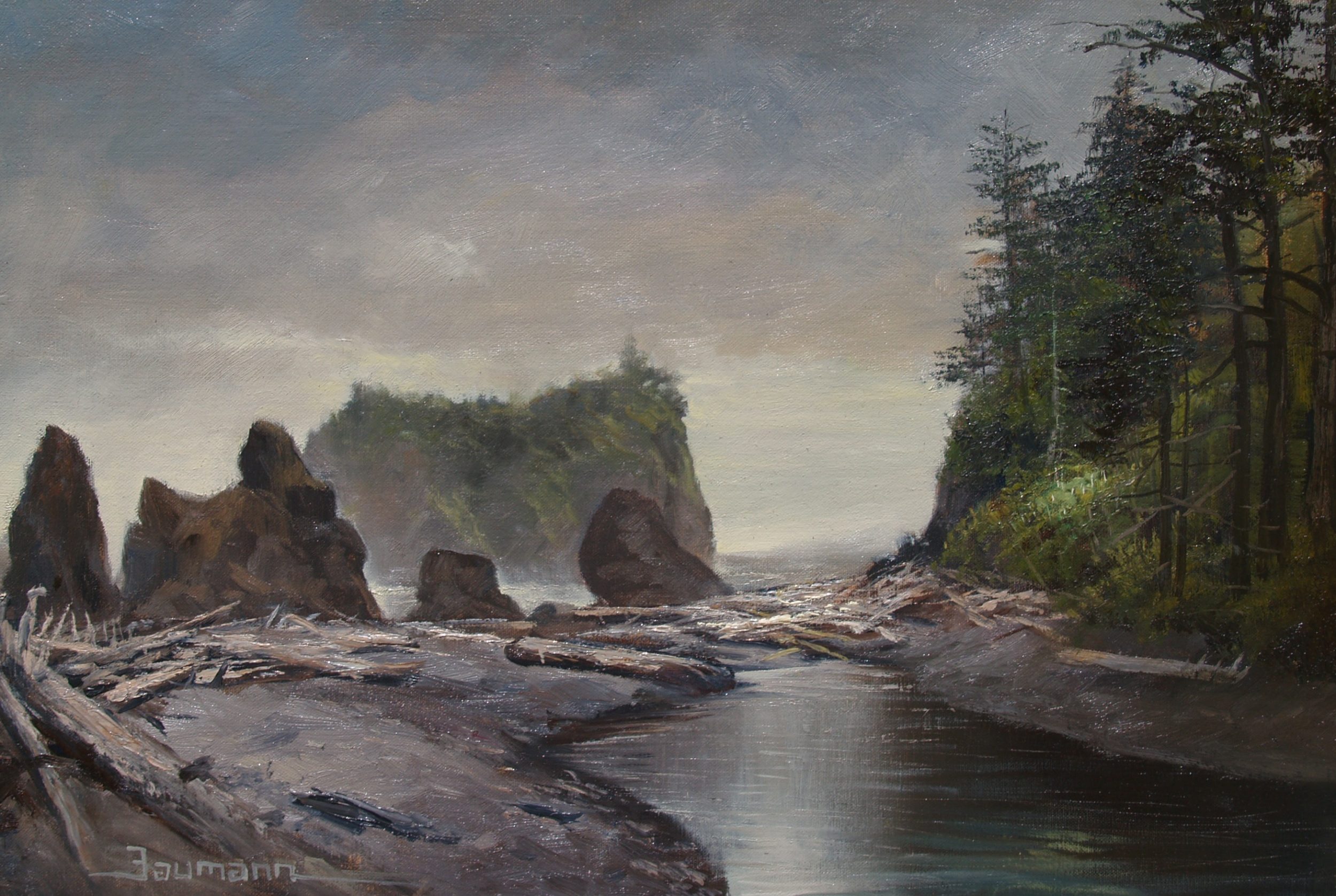“Misty Morning in Olympic National Park”
The first time I traveled to Olympic National Park, I went to paint a scene of a foggy morning on the coastline in the Park for my PBS series, “The Grand View, America’s National Park through the Eyes of an Artist.” We drove through the Elma Valley and over to the Olympic peninsula where more than 73 miles of the northern Pacific coast is protected by the Olympic National Park. Visitors are able to experience miles of magnificent coastline full of tide pools, sandy beaches, and rocky cliffs.
I chose a cold and foggy landscape to paint with a beach that was empty and quiet except for a few seals and the occasional burst of air and spray from a whale that broke the silence. After setting up, I began by imagining how I wanted the composition, the atmosphere, and the lighting to appear. When I started my painting it was a foggy morning but in less than an hour the light burst from behind the clouds and illuminated the shoreline. I faced the dilemma that plein air artists encounter at some time or other when plein air painting in changing conditions. What to do? Now that it has changed from a foggy morning to a sunny day, do I revamp the current scene and begin a new palette suited for the sunlight, or do I stay the course and paint what inspired me about the scene in the first place?
I believe that it is important to stay with the original excitement and inspiration of the scene that made the artist want to paint it in the first place. Sometimes the light changes, and in this case, the fog lifted, but since the light changes every 7 minutes and the weather changes at will, it’s futile to adjust the painting just to keep up with how it looks “now.” When I painted the locations for the PBS series, I was aware that just as I was inspired by the scene that I chose to paint, the viewer also felt inspired by their initial impression of the scene I was painting. I decided to continue painting the original fog and lighting in the scene, and I succeeded because I had trained my memory to be able to recreate my impression of what I first saw at 6 am when I began that morning. To help my memory, I made quick footnotes using dabs of light and dark paint that became part of my initial sketch. By darting all over my canvas, making color marks here and there as I drew the composition, I created enough hints so when the light changed, I didn’t have to be concerned because I had my color and value notes on the canvas.
It’s not easy to create visible mental notes, but it can be learned with practice. When plein air paintings are muddy, flat, and uninteresting, it’s usually because the painter does not know that painting on location relies on the skill to remember where the light initially landed and what values were found in the light and shadows at the beginning of the painting. Plein air painting is not just re-creating a vista and repeatedly chasing and changing the light. It is about remembering the original view and the feelings of being there that inspired the desire to paint that scene in the first place.
After I completed my painting, we traveled toward the high mountain peaks in the park by driving around the peninsula. Our efforts were rewarded with stunning vistas at every turn. We stopped to purchase some supplies in Port Angels, the main port where many visitors arrive on the ferries from Seattle. After filling the Silver Streak trailer with supplies, we headed west and traveled 17 miles to Hurricane Ridge where Olympic Park transforms into a fantastic alpine vista of snow covered glaciers. At an elevation of 5,242 feet, we saw spectacular views of the Olympic National Park with high mountains and sweeping meadows. This location reminded me of the opening scene of the Sound of Music when Julie Andrews twirled and sang. Olympic National Park is a jewel in the National Park system. It is one of the most beautiful destinations to visit when visiting Washington State and this park has it all; giant trees, rain forests, Native American history, high stunning alpine ridges, and seashores with endless beauty and distinction.
______________________________________________
Plein air and alla prima artist Stefan Baumann, host of the PBS painting series “The Grand View: America’s National Parks through the Eyes of an Artist” and author of “The Grand View: Observations Of Art and Nature,” travels in his vintage travel trailer painting America’s western landscape. Baumann paints outdoors with oils and canvas capturing stunning vistas, wildlife, western landscapes, National Parks and still life, thrilling art collectors throughout the world. He has many international collectors acquiring his paintings as investments. His painting style is called Romantic Realism with Luminism and he the extraordinary way he captures the effect of light is a truly an American Style used to paint the Western Landscape. He can be seen painting in Yellowstone, Yosemite and in the Grand Canyon. Baumann’s “how to paint” DVDs filmed on location in the National Parks are the very best on the market.


Trackbacks/Pingbacks